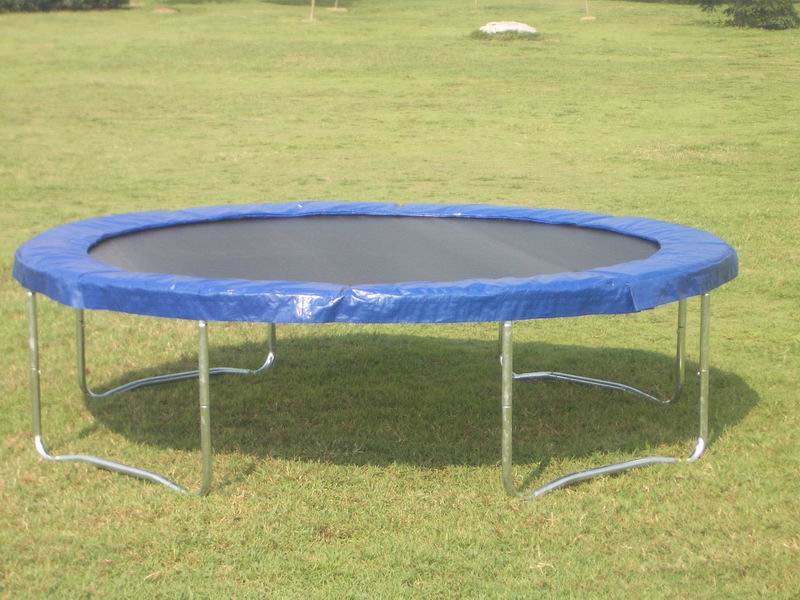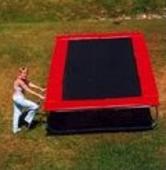I have now been on just about every trampolines from each of the main manufactures and now have my review. My results are based on my personal experience and interviews from people who have bought all these different brands. I try my best to validate the complaints I get with my own testing. I hope my site has helped you.
Depending on the safety, the responsiveness and ballistic impact of the bounce, and longevity of it, I will go over the differences that I could not get a strait answer from trampoline companies when I grilled them with my questions, just like I did with mini trampolines. I also own HealthyTrampolines.com and JumpStiltsReviewed.com. Bouncing is my passion.
Spring count: More or less springs - When you want less or more:
Just for recreation or having kids bounce you don't need more springs if you want to do tricks with a more responsive mat. Beware of more springs with less dense and lighter springs. Some have less springs but denser. More springs mean higher jumping. Look for high carbon springs with highest melting point for spring tension lasting longer.
Quality: I will say that the trampolines built in the USA and Canada are built with better materials than the ones made in China. I get most complaints from Chinese built models, not offence to my Chinese friends.
Dual or tripple jumpers: This adds more stress to the springs and most kids when they have their friends over is the time when a safety net is most needed. If you plan on having more than one person jumping most of the time, I look for beds that don't have excessive gravitational pull to the center, you will be thanking me later.
Mat Types: Some are melted with heated rollers to seal in the weaves and seams. Some are not. Their are pros and cons to each but the people who are jumping bare foot will like the softer feel of a melted mat. Kinda like searing a tuna steak, it helps so that the threads down't shift to one side and create open holes in the mat. Without searing, the threads can squeeze and clump together and really doesnt feel good to the foot. Not all Permatron mats are the same.
There are many types of mats you can use. Some are just one step above a potatoe sack.
Frame: Please know the weight before anything. More weight equals more grounded. Also, if the area is rainy, amke sure that the frame is a non-rust type so you can let it snow on it for months and wont' come back to a rusty trampoline in the spring. Corrogated bar types feel the most rooted. The fewer the pieces in frames the better.
This is the largest Octogonal trampoline I have tested having the most springs.
Shape types: If I want to do crazy flips and jump to the moon, then definately the square or rectangle ones. The non round ones are always more expensive. They have different tensions closer to the edges and have a smaller sweet spot but most people enjoy the circular ones as they keep me more centered. If I get close to the edges, the circular ones tend to keep bouncing you to the center as their is always an inverted or (coned in) state on a round one. With the rectangle ones, more springs are bouncing you upward as they are lined up for you so you have more springs giving you resistance especially at the high bounce heights. But, the rectangle ones don't cone in like the round ones and don't push you backto the center.
Note: when you bounce on a circular trampoline, it doesnt thrrow you up at at perfect right angle to the ground. The more you are near the edge it will alwasy through a few degress to the center.
Round trampoline notice: Why some are more expenisve than others..
Make sure that the gauge of the medal making up the frame is at least 16 gauge or over. The lower the guage the weaker the frame will be and less grounded it will feel on the ground as you decelerate. Also the cheap way of getting high gauge steel is to break it up into pieces. The lower the number of assembly parts to make up the frame the more solid it will be. I try to avoid frames that are 15 pieces or more. The less pieces that make up the frame the less of a gauge you can get by with. It's ok to have a 15 gauge frame if its only 10 pieces. We are not building bridges here. We don't need more breaks in the bridge. A 20 piece rectangle frame that has 12 gauge, for example, I would not consider that a quality trampoline but if it had under 10 pieces, it would make it excellent. Know the gravitational pull to the center strength. Some have more pull than others.
Safety nets: I only recommend the net start from after the springs and have a mat to protect, not the other way around having it in front of the springs. I cannot emphasize this more. Too many people callign me are saying the same thing too. This is even more of an issue if 2 or more people are jumping on the trampoline and use the net for safety at the same time.
Spring weight: Coil count ( how many times the coil turns, the loops)
The weight is more important cuz you have to measure the weight times the coils and you get the tensions and ballistic impact ratings. Its the formula I created when trying to measure the ballistic impact with mini trampolines. Some springs are 7 ounces each and some are less and more. 7 seems to be the standard or average weight. Some are heavier but shorter and others are the same weight and longer which I think is misleading cuz the trampoline looks substanceal when its really not. Springs can be upgraded to provide extra support. I don't like jumping on non infused springs.
Stitching: Know the ply rate. The average is about 4 rows of stitching. More is alwasy better. The most important thing to know is if it is stitched with nylon threading or Polyheaster or Teflon threading. Some mats have 10 stitching rows.
Spring Replacements- Some will need to be replaced every 2 years and some will last 3 years of continuous use. The ones where you get an extra year out of it wil The springs that are cheap lose responsiveness after a year. You can read my spring page on my site and know that nothing slides past me when companies tell me about their springs.
Note: some are coated with zinc to keep it from rusting, others are galvanized. If you notice, some are shiny and others are not. Each have their pros and cons. Most of the complaints are from the simple chrome springs, the non shiny ones you see a lot.. With cheap springs, if one loses its tension, you gotta replace all all of them, not just that one cuz the springs next to it will start to carry the resistance of the weaker spring and then the whole trampoline will start to feel crappy.
I always make sure that the springs I promote are made of galvanized steal, not the steel that becomes stretched out over too little time. A good spring should last up to 10 years.
I factor in everythign I can on my end and more if I know the types of users and their weights and jumping styles. I factor in the coil count per inch, not just hte whole spring. Also the dia meter of the coils just like I had to do on the rebounders. So, its not just about having longer springs or bigger coils, its the type of steal and densities. Just having larger coils and more of them can fool people. There are cheap ways of making a spring and springs that are made with cost not being a factor. Not everyone needs the best and getting the right type for the person is what the goal is.
Spring lengths:
The lengths range usually from 3 1/2 inches up to 9 inches on most stock springs. Some are larger but this is for ultra high performance trampolines and it gets tricky after the 9 inch mark. The longer the more the spring has to stretch to give that pop at the end of the stretch. The responsiveness is not immediate like the shorter springs. Again, each length has its own pros and cons. You don't want to bottom out and hit the grass on a spring that is not right. A very heavy person might need a different spring length than a lighter person. A longer spring allows for deeper bounces but many people want that but don't know the length to get based on their weight. Its best to know the weights of all the users and try to get the spring length that will be the best for the average of all users, unless you can get thgat perfect length for one user in mind.
Covers: Some are denser than other and absorb more impact than others. Its better to get a thicker cover if using a non circular one as it doesn't pull you to the centeras much. The thickness of the cover is also important for heavier people. Most are about 1 inch thick which is the average. You can have a thicker cover but make sure you know the density of it. Some are 18 ounces and some go up to 22 or more ounces. Density is just as important as thickness. UV coating it also helps so that the sun doesn't leach the formaldehydes and compounds that make the cover lose its cushioning. A good cover should last at least 2 years if Uv coated in the full sun. It reminds me of buying boxing gloves. You can get 16 ounce gloves you can get 10 ounce gloves. I hear complaints on padding wearing out sooner than it should and am weeding out brands that I can validate that. I will look at the samples of the covers and try to find out why they wore out. Naugahyde covers like on boxing gloves are the most most expensive and best.
Weaving: Know the porosity of the mat. Some have more pores that allow more air to seep threw when bouncing, especially if trying to bounce high. If the mat has less holes, it has to push more air and it slows down the mat giving a lower bounce and more of a push than a pop feel. The bounciest trampolines have to push less air, simply put. There are different types of mat materials. Just like mini trampolines, each weave feels different and gives adifferent bounce. I personally like Permatron mats the best.
Make sure that they warranty if for heavy people. If someone is 350 lbs and the springs lose tensile strength in the first 6 months, they might say you abused it.
If the springs are bottoming out and the ballistic impact gets too high at the bottom of the bounce and you don't like it. Tough. That is not a malfunction. Just that you bought cheap springs. Good springs should absorb the shock and also maintain its acceleration at least throughout the first year, especially if high bouncing.
This is the largest Octogonal trampoline I have tested having the most springs.Just about all trampolines are not noisy at first. I happened to find a youtube video and was the first random video I found. This is I guess what most people complain about when they call me about the ones they want to get rid of.
Take the Trampoline Quiz:
Get the best bounce based on the answers you choose. I will review your answers and make a recommendation.
Do you want to do flips?
Are you a beginner at trampolining?
Do you have any balance concerns?
What is the height you want to be able to bounce to?
What is the heaviest weight person that will be bouncing?
Note that 100 lbs at 3 G forces is really like 300 lbs of force on the springs and frame)
Balance issues?
What is the heaviest and lightest weight that will be on the trampoline?
Lightest weight:
Heaviest weight:
What size trampoline do you need?
What type of quality do you want?
Name:
Number:
Email:
Best time to call:
comments/ feedback = discounts :)
Connecting:
Which his more important?
What type of climate will you keep your trampoline?
Usage?
Do you suffer from back pain?
Is noise a concern?
What shape do you like the most?
Is static an issue for you?
...because they all said they have the best quality and bounce
1-877-336-7890
Open from
8am till 10pm
Rectangle-Trampolines-Reviewed.com
1-877-336-7890
Open from
8am till 10pm



















